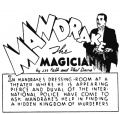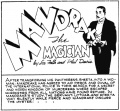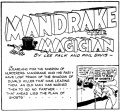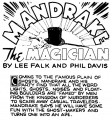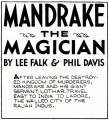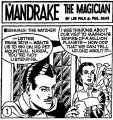Spotlight on Sunday strip layout: Difference between revisions
mNo edit summary |
|||
| Line 28: | Line 28: | ||
Image:ms-logo-03-b.jpg | Image:ms-logo-03-b.jpg | ||
Image:ms-logo-03-c.jpg | Image:ms-logo-03-c.jpg | ||
Image:ms-logo-03-d.jpg | |||
</gallery> | </gallery> | ||
Revision as of 18:05, 18 July 2013
The full page years
The early Mandrake Sunday strips filled an entire newspaper page. Phil Davis layout his first Sunday story with 4 strips a page before he started experimenting with different variants of layout. The various pages could have 2, 3 or 4 strips and some panels could span more than one row.
In the first Sunday story Phil Davis also experimented with the logo for the pages.
The first Sunday page logo and variants
The second Sunday page logo and variants
The third Sunday page logo and variants
The full and half page years
Because of paper shortages during World War II some newspapers requested possibility to print the Mandrake Sunday strips on a half page. Phil Davis started to layout the pages so the numbered panels could be rearranged to fit both a full or half page. The last page made for full page only was at April 26, 1942.
- Ms-logo-05-a.jpg
|
This article, or section of an article, is very short. You can help MandrakeWiki by expanding it. |
After the war, strips continued to get smaller and smaller, to save the expense of printing so many color pages.
When Sunday strips began to appear in more than one format, it became necessary for the cartoonist to follow a standardized strip layout, which provides newspapers with the greatest flexibility in determining how to print a strip.
Sunday strip layout 4
- S-layout 70-full.png
designed to fill full a newspaper page



